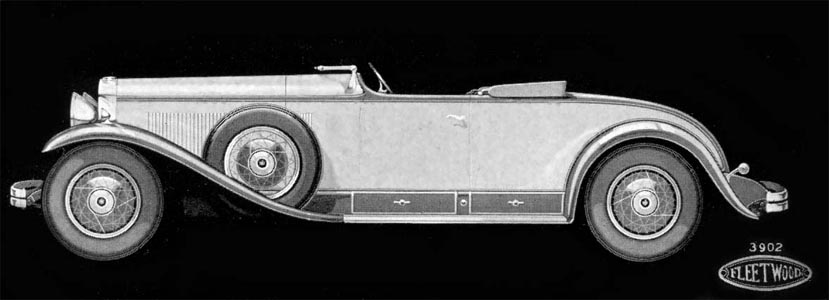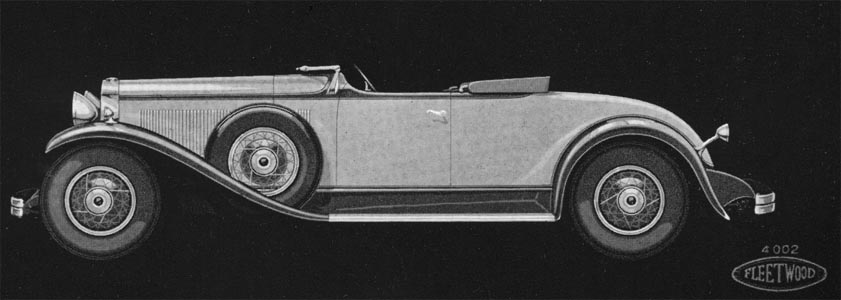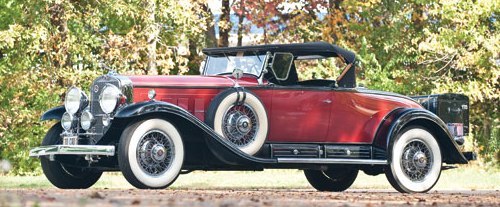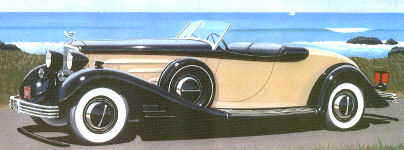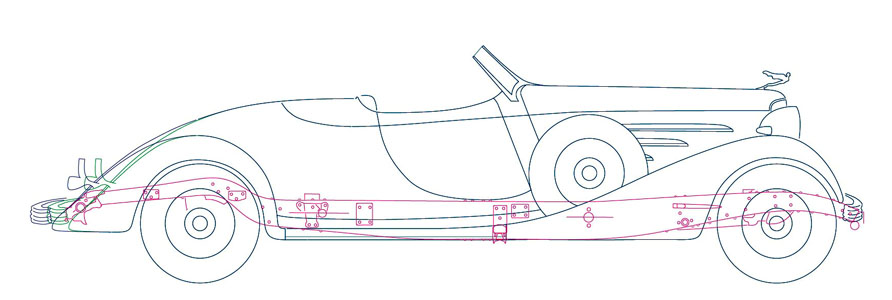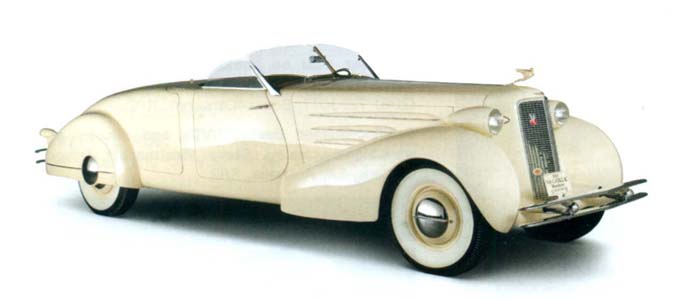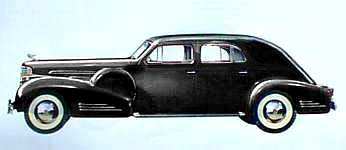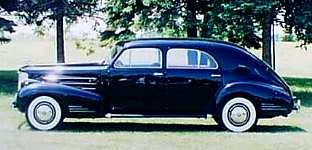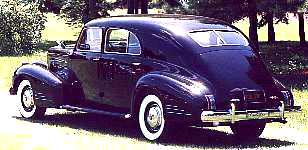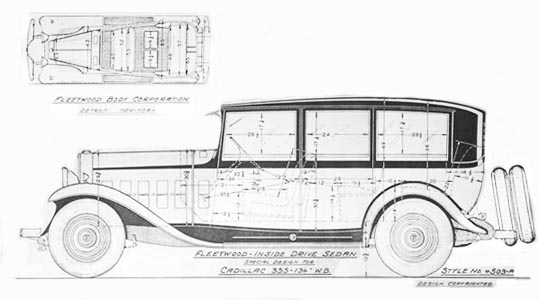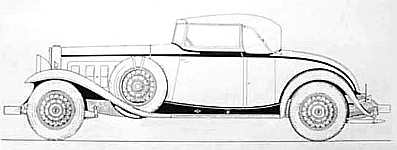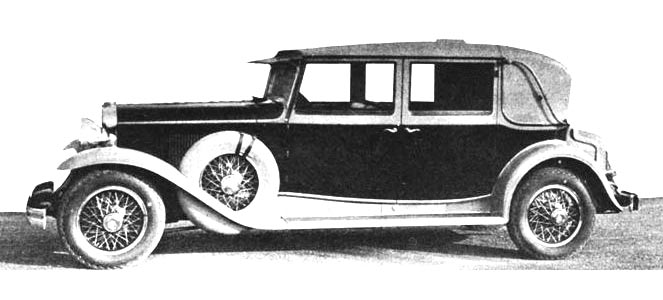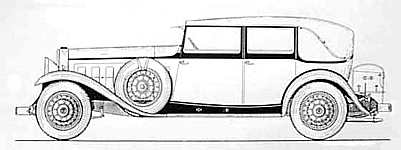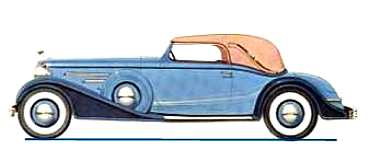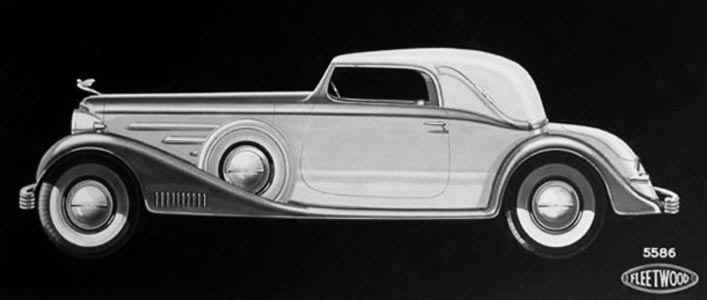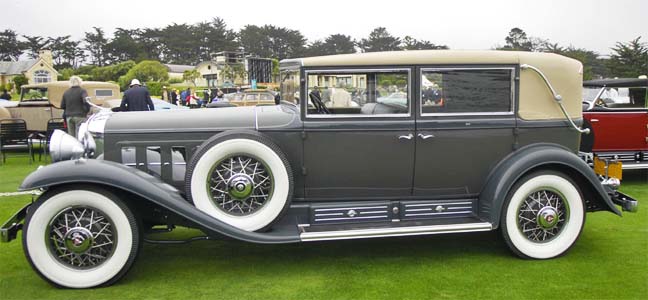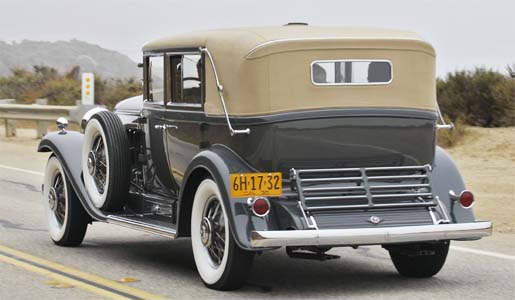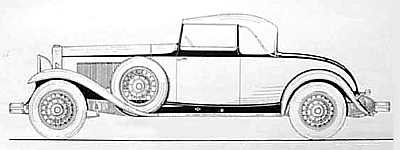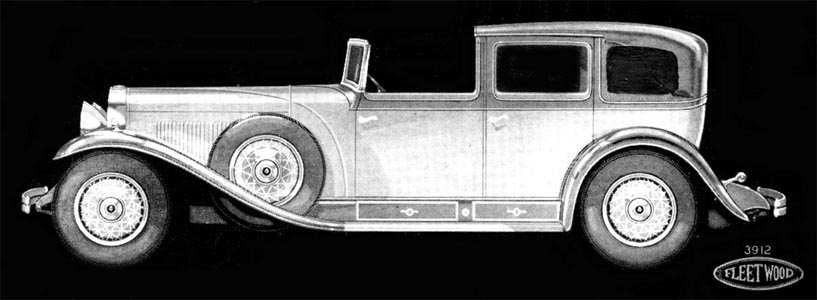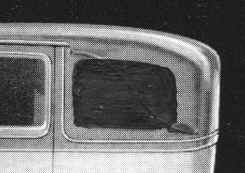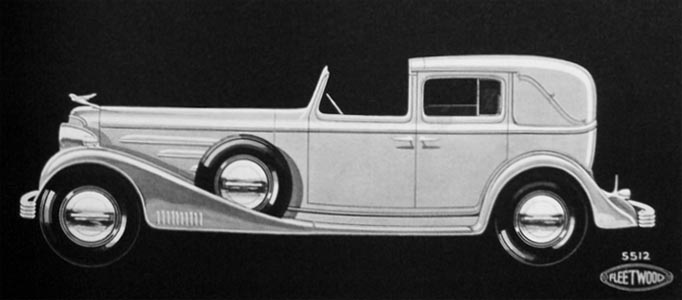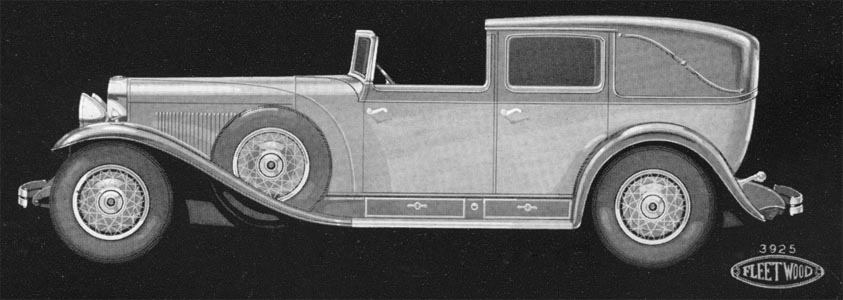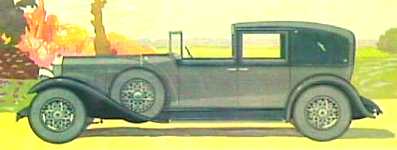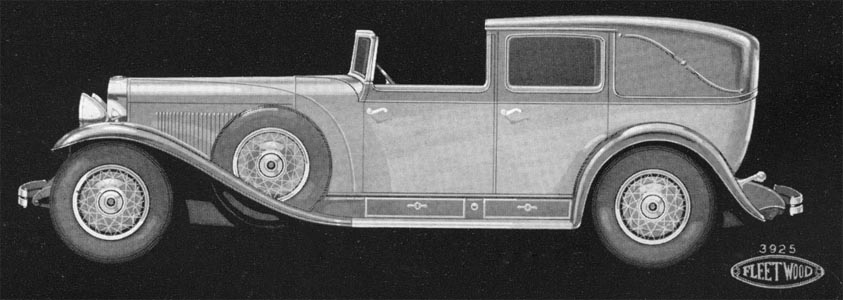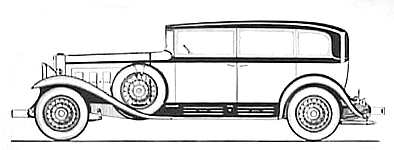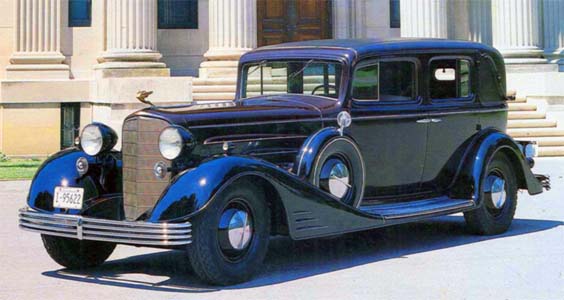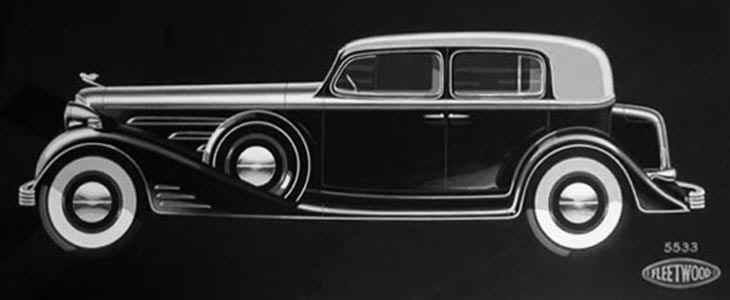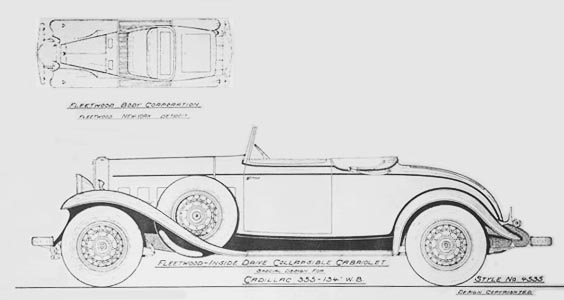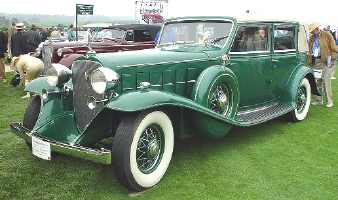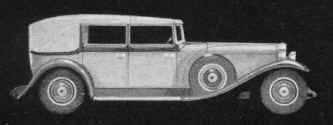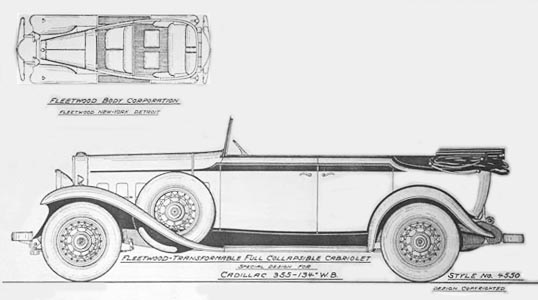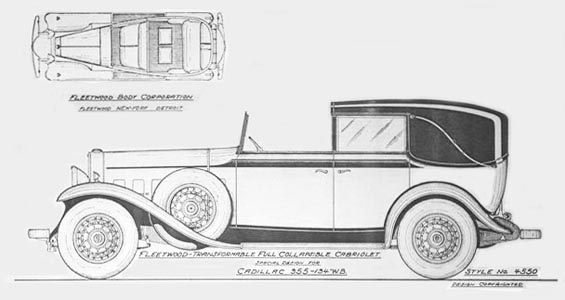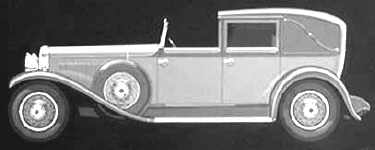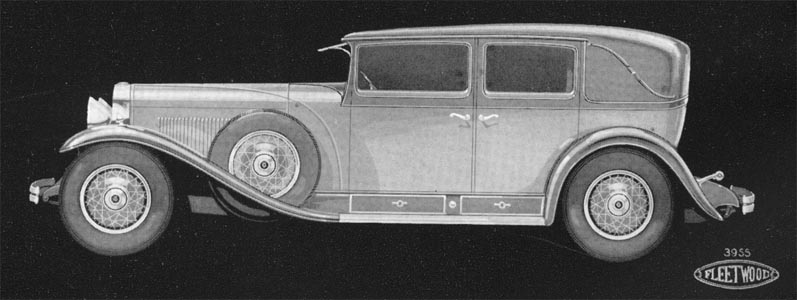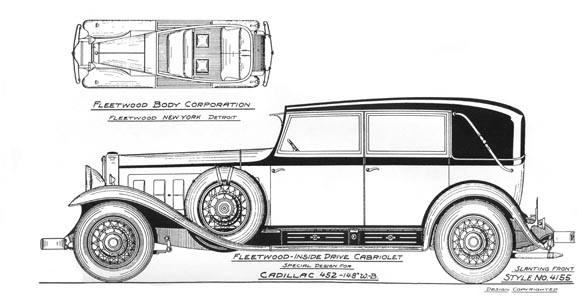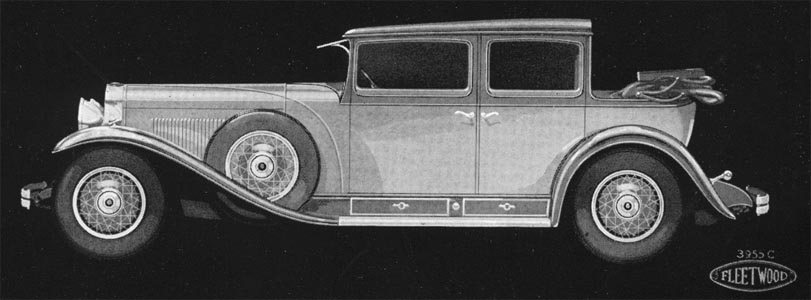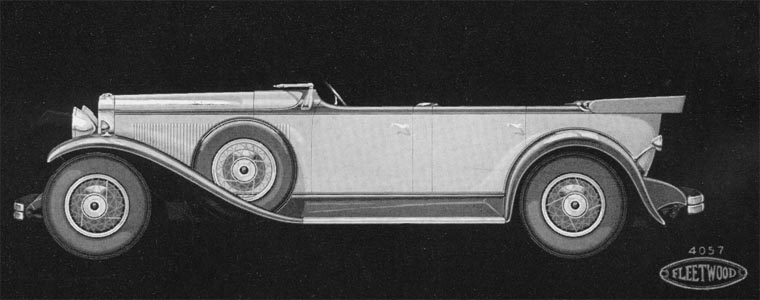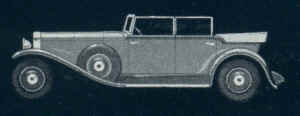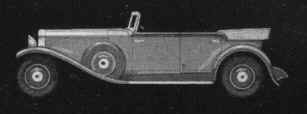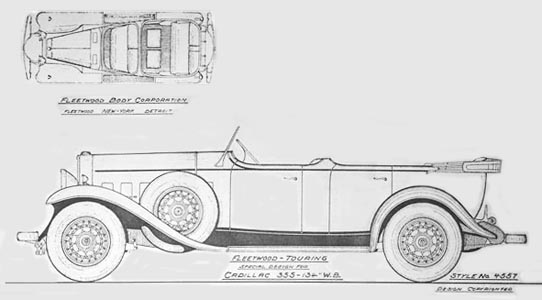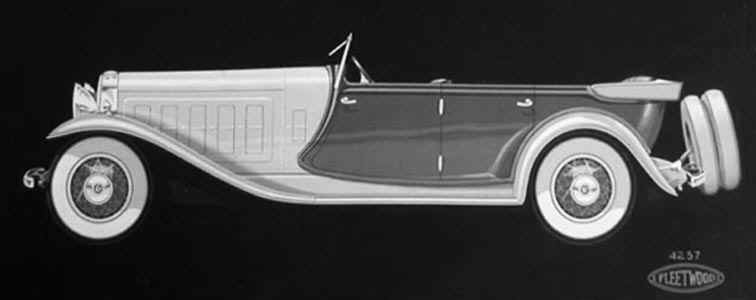| 00 (1) | 1927 style #3200, a town car for 7 passengers with leather-covered roof and opera seats |
| 00 (2) | 1928 style #8000, a 7-passenger sedan with metal back, full ¼-windows and front facing auxiliary seats |
| 00 (2a) | 1929 style #8600, was described as a Convertible Landau Cabriolet designed to be owner driven; with imperial partition added, it became style #8605 (below) |
| 00 (3) | Also built in 1928 was style #3300, described as a 7-passenger convertible cabriolet |
| 00 (4) | 1930 style #4200, a unique 7-passenger limousine
style built on the early V-16 chassis [Series 452]. Read
all about it in the Database section on the sixteen-cylinder Cadillac models.
I was fortunate to get a factory designer's drawing for this style [slightly
modified - text removed], in 2001, from fellow CLC member and V-16 enthusiast,
Craig Watrous.
|
| 00L | 1928 style #8000L, a 7-passenger sedan on the 140" wheel base V-8 chassis for 1928; this car featured a leather roof covering. The suffix "L" was used also to designate a car used in "Livery" service |
| 02 (1) | 1927 style #3202, a 2-passenger coupe with rumble seat
|
| 02 (2) | (a) 1930 style #3902 Fleetdowns, a
2-passenger roadster on 140" wheel base (= 355.5cms); the overall length of this car
was 211" (= 536 cms.), o.a. width: 74¾" (= 190 cms); basic equipment included
an adjustable front seat, flat, non-glare, swing-out, folding windshield, a cowl-top
ventilator, rain-tight side-curtains stowed in a compartment in back of the front seat, a
rumble seat, carpet mats in the front and rear compartments, chromium-plated foot rail in
the rumble area, a small door on the RH side of rear body for access to the rear
compartment, a cover for the top when folded down, Fleetwood-designed chromium-plated
hardware (b) style #4002 termed the La Salle Fleetcliff roadster in the Book of Fleetwood; a 2-passenger convertible style with folding windshield and rumble seat as above; the price was $2450; (c) style #4502, Cadillac 2-passenger roadster, 1931 (d) style #4602 La Salle roadster in the Book of Fleetwood; a 2-passenger convertible style with folding windshield and rumble seat as above; 150 were built; the price was $2450; (e) style #4702, Cadillac V-12 2-passenger roadster, 1931
(f) V-16 style #4302, again a 2-passenger roadster with rumble seat; I have an artist's drawing of the LH side; the base price is shown as $5350; 105 units were built.
|
| 02 (4) | In 2011-12 a Dutch aficionado
decided to build a roadster on the 1933 V16 chassis, based on Fleetwood
catalog drawings (style #5502); such a creation may not be properly termed "replica",
"reproduction" or "recreation" roadsters, since none were affectively built
by Fleetwood. The term "fake" is perhaps too strong; I call these creations
"imitation" or
"modern-day" roadsters inspired by original Fleetwood designs.
A similar "imitation" was built ona 1934 Cadillac V16 chassis by a well-known
Chicago repair shop (Fran Roxas) in the 80s (style #5802)
|
| 02 (5) | Probably "job" rather than
"style" #9002, this was one of two special 4-door sedans built on the 148"
wheel base V-16 chassis in 1938. This one was a fastback style; it was built on
chassis/engine #5270306 for GM Vice-President William "Bunkie" Knudsen. Its
special features are described in CLC story, 6/91 by Ron Van Gelderen. Click here to read about it. A second special job,
also on a 148" wheel base chassis, with 1938 V-16 chassis/engine #5270306 carried a
similar "job" number [probably #9003, #9004 or #9005]. It was built for GM
Chairman Alfred P. Sloan. Nothing is known of its special features, although I believe the
build sheet is available in the factory archives
|
| 03 | Style 4503 on 134" wheel base V-8 (and V12?) Cadillac chassis for 1931; this was
described as a 7-passenger sedan; the number was used again in 1936-37 for style #7503.
|
| 03L | Style #7503L (1937); a formal version of the former 7-passenger sedan; presumably the "L" suffix meant "Livery" rather than "Leather" in this case, these large sedans and limousines being frequently used as chauffeur-driven rentals |
| 04 | In early 1997 one of my knowledgeable correspondents viewed some original Fleetwood art work for 1931 including a styling proposal #4804 which I assume was a custom 2-passenger coupe or convertible (to my knowledge it was never built) |
| 05 (1) | 1928 style #8005, a 7-passenger sedan with leather covered roof, no landau irons, full ¼-windows and forward-facing auxiliary seats [McC, p.122] |
| 05 (2) | 1929 style #8605, was described as a Convertible Landau Cabriolet with imperial partition, derived from style #8600 (the owner-driven version) |
| 05 (3) | 1930-31 V-16 proposal, style #4205; this was
called a Fleetwood touring car; the designer's drawing [slightly modified - text
removed] I got in 2001 from fellow CLC member and V-16 enthusiast, Craig Watrous, shows a
large open car, with Fleetwoods "V" windshield, no auxiliary seating and a
spacious fitted trunk in the rear; unlike other V-16 designs this one featured vertical
hood louvers similar to those used on the 1929 and 1930 Fleetwood styles, as well as the
older style, bulbous tail-lights and two-bar bumpers front and rear.
|
| 06 (1) | Style #4206 on the 1930 Series "452" V-16
chassis was a unique 2-door, 2-passenger hardtop coupe which Fleetwood termed a Stationary
coupe cabriolet; the term "cabriolet", a favorite with Fleetwood, is a
misnomer in that the French word cabriolet means a convertible, whereas all the
Fleetwood so-called "cabriolets" were ...hardtops, featuring a leather [or cloth
???] covering applied to the fixed metal roof; the French designation "faux-cabriolet"
(a false or imitation convertible) would have been more appropriate. A press photo of this
car shows it to have a light-colored top suggesting the use of the fashionable French coupienne,
a fabric-grained leather imitating Burbank material; this was a styling feature popular
with Californian buyers and it is possible that cars thus "covered" were
finished in Los Angeles by specialists at the Don Lee body works. [H,
p.65). Style #4206 featured a special belt molding and a split "V"-type,
slightly raked windshield, false landau bars and a rumble seat; only one was built. I got
a designer's drawing [slightly modified - text removed] for this style, in 2001, from
fellow CLC member and V-16 enthusiast, Craig Watrous.
|
| 06 (2) | In this case, I believed the number merely indicates
"special job" #9006 on the second generation V-16 chassis, the Series 90.
This was a special, unique 4-door convertible sedan. Two were built as a White House
security cars; they were delivered to the secret service and were in use for many years;
the V-16 motors subsequently were replaced by V-8s for reasons of economy. These huge cars
were built on an extended wheel base chassis (165" [4m19] instead of 141"
[3m58]). Click here to read more about
them.
|
| 07 | Style #4207 built in March 1930 on the 1930 Series
452 V-16 chassis [three (3) units only]; this is a rare 2-door, 2-passenger coupe
termed Stationary coupe cabriolet by Fleetwood; like style #4206 it had a fixed,
leather covered roof; factory photos and drawings again show a light top color suggesting
the use of the fashionable French coupienne, a fabric-grained leather imitating
Burbank; style #4207 featured a special belt molding and flat, slanting windshield, false
landau bars and a rumble seat. Of the three such cars completed; the first of them, on
V-16 chassis No. 701078, was shipped to Dave Towell Cadillac in Akron, Ohio, on 15 April
1930; the body was painted black with silver (argent) moldings, while the chassis and
underside of the fenders were painted emerald green [wow !]; the fenders featured chrome
edge moldings [a styling feature that became popular again in the 60s and 70s!] and the
car sported the modish wire wheels; the (presumably pessimist) owner of this particular
car ordered it with two side-mounted spares ...as well as a third spare concealed under
the rear deck (he probably was the kind to wear suspenders ...and a belt!) A
radio and hood locks [left and right] completed the accessory equipment. The owner was a
wealthy person, being able to spend $9875 for the car; this was an astronomical sum right
after the Wall Street crash in black October 1929 ...and considering that a new Chevy
could be bought for less than $500 (in 1930 the V-16 chassis alone cost $4800)! This
lovely coupe cost more than the most highly-priced of all the basic Fleetwood V-16 body
styles, i.e. the razor-edged town brougham, style #4264B, that listed for $9500. I got a
designer's drawing [slightly modified - text removed] for this style, in 2001, from fellow
CLC member and V-16 enthusiast, Craig Watrous.
|
| 07 (2) | Pre- and post-war styling code digits, e.g. style #6107, Cadillac's first fastback coupe, built in 1942, and style #6207, a more luxuriously finished fastback coupe also built in 1942, as well as from 1946 through 1949 |
| 08 (1) | 1928-29 style #3208-C [below], termed an "Imperial
Landaulette" (with folding rear roof quarters) was reportedly built "for an important motor-car
executive" on a late 1929 Cadillac 314-B commercial chassis
[#336343 - body #13140] on the
152" [3m86] wheelbase; it was 4" (10cms) longer than the V-16 chassis
later used from 1930 (... and almost as long as the chassis for the 1934-37 V16s).
The top was covered with Coupienne
(a fabric-grained leather introduced at the 1928 Paris Salon by
renowned French coach-builder, Georges Kellner; it was said to be easier to clean than regular fabric
or leather. The following year, Fleetwood put this rare
body style on four V16 chassis [below] wheel base chassis.
This car features a special, curved or "coach" sill that previewed the
first-generation V-16 models identified by initial digits "42..". The
parking lights were mounted on the front fenders, as they would be on all 1929 Cadillac
models. The descriptive text added that the sporting effect of the body is enhanced by
the mail coach sill and the light leather top which has a Burbank grain. The car was
finished in maroon and Paris gray, the latter being used for the splashers, fenders,
moldings, top leather and trunk which was covered with the same Burbank-grained leather as
the top, and harmonized pleasingly with the contour of the top. The wires wheels were
chromium-plated. The car had a Neutralite glass visor giving true traffic light colors,
narrow front corner pillars [a la Madame X], an automatic ventilator in the
roof and no finish molding over the roof joint. A division glass separated the driver and
passenger compartments and the interior was trimmed in maroon [Radel?] Aero leather on
both the seats and doors; a dark maroon snakewood was used on the door and division
friezes.
|
| 08 (2) | Fleetwood V-16 style #4208 was termed an imperial
cabriolet; today we would call it a hardtop limousine; it had a glass division
between the driver and passenger compartments. Like the above car and like styles #4206
and #4207, it featured the fashionable, light-colored leather top imitating Burbank, which
was much in vogue in Europe. Auto writers of the time referred to it as the leather
which has the modish fabric grain or "coupienne"; the latter word was
coined by French coach builder, Alexis Kellner, who had introduced the new material at the
1928 Paris Salon to overcome the difficult chore of cleaning light-colored canvas
tops. Fleetwood exhibited a similar car [style #4200], on the 1930 V-16 chassis, at
the following Paris Salon, in October. The leather faux-convertible
tops were popular with Californian buyers. It is possible that such cars were
finished by Don Lee in San Francisco. Only eight units of V-16 style #4208 were built. I
got a designer's drawing [slightly modified - text removed] for this style,
in 2001, from fellow CLC member and V-16 enthusiast, Craig Watrous. It features a
spacious, rack mounted trunk in the rear.
|
| 08 (3) | e.g. 1933 Fleetwood V-16 style #5508 (four built).
Fleetwood had a number of surprising styling codes for bodies mounted on the 143"
[3m63] wheel base V-16 chassis in 1933. However, so few of them were built (125 units,
plus one "unknown" chassis) that it is not surprising that individual orders got
a special style or job number unlike the standard codes. In this case we are looking
at a 2-passenger convertible coupe on the shorter 143" [3m63] wheel base for 1933.
Neither this particular car nor style #5509 (2-passenger coupe) appear in the Fleetwood
catalog for 1933. My hunch is that Fleetwood simply custom-finished (for a couple of
wealthy clients) a Fisher-bodied 2-passenger convertible coupe (style #168) and a
2-passenger coupe (style #158), re-numbering them #5508 and #5509 respectively.
|
| 08C (2) | V-16 style #4108C, termed by Fleetwood an imperial
Landau cabriolet, i.e. a limousine (with division glass), leather-covered top and
folding roof portion over the rear seating area. This is a controversial style, to say the
least. You can read all about it in the Database section on the sixteen-cylinder
Cadillac models. Only four of these cars are reported to have been built. Barring the
"C" suffix, which identifies the landaulet roof, and the light-colored leather
roof covering, these cars are fundamentally identical to Pennsylvania-built Fleetwood
style #4155, with its vertical, split "V" windshield and matching
"half-round" or "quarter moon" split instrument panel found only on
these cars and on Pennsylvania-built styles #4130 and #4175. On these panels, the
instruments were evenly distributed between the LH and RH sides of the board. Click here to read more about it
|
| 09 (1) | V-16 style #5509, a 2-passenger coupe of which only
two were built. in 1933, on the 143" wheel base; this style is not illustrated in the
Fleetwood catalog for 1933, perhaps because of the different wheel base [the remainder of
the 1933 V-16s, with the exception of two cars with bodies by Fisher - a 2-passenger
convertible coupe and a 5-passenger coupe - were built on the 149" wheel base]. As
neither this particular car nor style #5508, above (a 2-passenger convertible coupe),
appear in the Fleetwood catalog for 1933; my hunch, again, is that Fleetwood
custom-finished, in this case, a Fisher-bodied 2-passenger coupe (style #158), and
re-numbered it #5509. e.g. 1933 Fleetwood V-16 style #5508 (four built). As mentioned
earlier, Fleetwood had a number of surprising styling codes for bodies mounted on the V-16
chassis in 1933. So few cars were built on the sixteen-cylinder chassis that it is not
surprising that individual orders got a special style or job number unlike the standard
codes.
|
| 09 (2) | La Salle style #5009 (1935), 5-passenger, 4-door sedan, 100 units. |
| 09D | Pre- and post-war styling code digits, e.g. Cadillac style #6109D sedan (1941-1942 and 1946-1947); the "D" suffix stands for De Luxe (special finish interior) |
| 09F | Cadillac style #7509F (1937), 5-passenger formal sedan |
